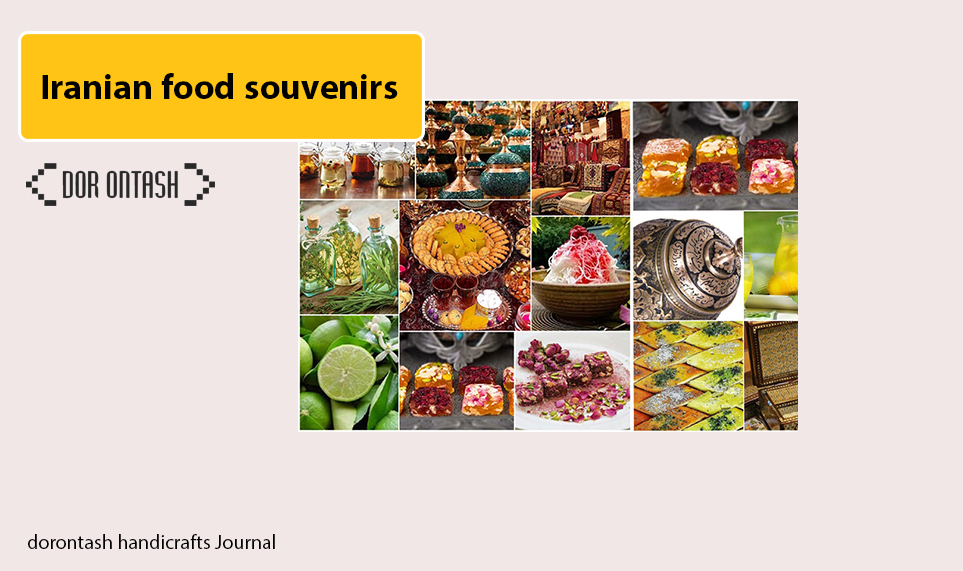Iranian art is one of the richest artistic heritages in the history of the world and includes many disciplines including architecture, painting, weaving, pottery, music, calligraphy and metalwork. In this section, the Asmoni portal investigates the characteristics of literary and artistic works of the past eras and has prepared and organized useful and readable information about the history of Iranian art for you, which you will read below.
The evolution of Iranian art can be found in the roots of the historical events of this country. It seems that the different climate of Iran has had its effect on the early inhabitants of this land in the emergence of various arts in various historical periods. Iran’s mountains, deserts and natural phenomena are among them, which have created various artistic categories in ancient times. The plateau of Iran, the remnants of the old mountains, was inhabited by the early Aryans ten thousand years ago. The houses are between 6 and 8 thousand years old. The remains of these works are located on the two mountain slopes of Iran with the Alborz and Zagros mountains. Archeologists’ excavations in these two areas have found very important works of art including cavemen’s paintings, household appliances and metal tools, and war tools.
Zagros mountains have been the center of various nomads. Undoubtedly, most of the metal elements of the second millennium that are visible today were in the Lorestan region, a large amount of these works are on display in the Lorestan Ancient Cultural Museum, another mountainous region of Iran that is very important in the history of Iranian art, and very important works of art in Its domain is found; Alborz mountain range. The northern slopes of this mountain range, Mazandaran and Gilan, are inhabited by the ancient races of Iran. Early metal vessels of Marlik type in a hill with the same name in Rudbar in Gilan region, belong to three thousand years before Christ. These vessels, which are made and decorated with gold, silver and metal, represent the race that archaeologists believe founded the powerful empire of the Medes in the first millennium BC with the Indo-European group – based in the Iranian plateau.
On the far side of the Iranian desert near Kashan – in an area called Sialak, the first traces of the inhabitants of the central regions of Iran have been found. The Sialaks made their tools from stone and gradually used sharp stones. The artistic taste of these people is visible in the bone carvings that were done for the first time.
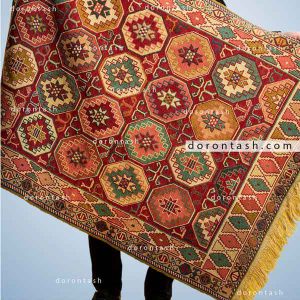 the Caucasus and the eastern regions of Anatolia. This cultural period is known as the Urartu civilization. Archaeological research in this field, in areas such as Azarbaijan, Isfahan , Shiraz and Tehran suburbs, includes castles and fortifications of this civilization, and valuable works of art. One of the oldest works, Urartu; Remains of Bastam Castle around Lake Urmia in western Azerbaijan include rooms, seralabs, guard tower, shops and other parts. Two water mills that worked with water from the nearby river have also been discovered.
the Caucasus and the eastern regions of Anatolia. This cultural period is known as the Urartu civilization. Archaeological research in this field, in areas such as Azarbaijan, Isfahan , Shiraz and Tehran suburbs, includes castles and fortifications of this civilization, and valuable works of art. One of the oldest works, Urartu; Remains of Bastam Castle around Lake Urmia in western Azerbaijan include rooms, seralabs, guard tower, shops and other parts. Two water mills that worked with water from the nearby river have also been discovered.
In the excavations of this historical fort, necklaces, glass rings, clay seals, clay tools, and war weapons made of small stones, symbols of the residents of northwestern Iran, have been found. The most important work discovered in this castle; The Barst inscription is a hieroglyphic script that shows that the Urartu civilization had special writing letters. An interesting point that appears in the study of Iranian art is that Iranian art, independent of the place and time of its origin, reflects the spirit and tendencies of Iranians. Different regions have high skills.
video of iranian arts
History of artistic events in Iran
Historical tables help to know the history of artistic events in the country, their formation, evolution and development:
5 thousand years before Christ, the Iranians, who migrated in winters and summers, began to build clay houses, stone tools were improved and were completed by adding parts of bone, household items with red and black colors. They were painted and cooked in fire.
During 4000 years before Christ, the inhabitants of Zagros built villages and gradually lived densely and architecture was created. War tools in these areas were still made of stone, but at the end of this era, metal swords and daggers, inscriptions with the initial handwriting of Ilahis appeared.
3000 BC, white stone, bitumen and other types of stones were used to make art tools. Dark blue and charcoal sali dishes became popular. Metal weapons were used in different regions of Iran, such as Shush and Nahavand, and various ornaments were made of gold, agate, and lapis lazuli.
In two thousand years before Christ, the arrival of the Aryans to the Iranian plateau was the most important event, at that time the art of metal reached its peak of importance, the production of thin pottery spread in Alborz and its neighbors, and luxurious buildings with brick or brick walls were built. Baked pottery was decorated with paintings with designs of humans and constellations, trees and other figures. The developed urbanization and stone work reached a stage that gave beauty to Sush. At this time, tribes such as Aryans, Medes and Persians settled in Zagros.
In the first millennium BC: due to the lack of access to archaeological documents, the Black Age is called historical background. New findings provide information about this decade. At this time, rich shepherds and farmers lived in the slopes of Alborz and had valuable metal tools and valuable carved pottery works.
In the 6th and 7th century BC, due to the mass migration of different races to the Iranian plateau, such as Seattle, Oratos, Manila, Castis, Medes, and Pars, and finally the creation of the Achaemenid Empire, and due to the central organization of Iran, it entered the historical era. Since then, the studies have been kept in a timed and classified manner. Inscriptions written in Persian, Elamite, and Akkadian languages remain from the Achaemenid period and show valuable evidence of the greatness of Iran.
Iranian visual art courses
-
Achaemenid 550-350 BC
Valuable works in architecture and other arts were created during the Achaemenid period. The Achaemenid rule was extinguished after the occupation of Iran by Alexander the Great.
-
Seleucids, Parthians (91-312 BC)
The first Seljuk established the Seleucid kingdom. After the defeat of the Seleucids, Farhad II (129 BC) established the Parthian Empire and this dynasty existed until 224 AD.
-
Sassanids 642 – 224 AD
Many valuable and diverse works have been left from this era, which has a special place in the history of Iranian art. The extinction of the last Sassanid king (Yazdgerd III) by the Arab invasion was the end of this era and the beginning of a new history for Iran.
-
Early Islam (651-1000 AD)
The story of art in the years of Islamic era is remarkable. After other historical periods, Islamic art reached its peak. These years include:
- Seljuk era 1157 – 1000 AD
- The era of the Mongols 1370-1502
- Safavid era 1491-1772
- and the new period from 1772 until now
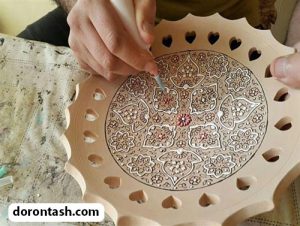 Outstanding Iranian arts
Outstanding Iranian arts
Carpet
The oldest example of Iranian carpet that has been found is a carpet with original Achaemenid motifs found in the frozen grave of one of the Scythian rulers in the Pazyrik Valley, 80 km from Outer Mongolia, and it is called Pazyrik Carpet. Researchers consider this carpet to be handwoven by Parthians or Medes. Iranian carpet has been famous and used for a long time. The Greek historian Xenophon writes in his biography of Cyrus: “Iranians spread carpets under their beds to make their bed soft.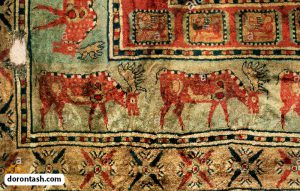
Iranian painting
Iranian painting, which is also called miniature, includes works from different periods of Iran’s history, mostly in the form of illustrations of literary books (Varqa and Golshah, Kalileh and Demeneh, Samak Ayar, etc.), scientific and technical (Al-Tariaq, Al-Adavieh Al-Morfada, Al-Aghani) , and…), historical (Jami al-Tawarikh, etc.), and also some religious books, such as Khavaran Namah.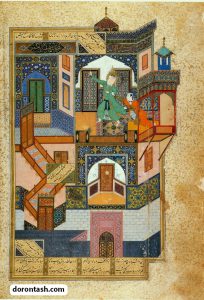
pottery and ceramics
Iranian pottery has a long history in Iranian history. Pottery is one of the first and most important inventions made by humans. It is one of the most important artistic manifestations for historians and archaeologists. Archaeologists learn about the social and economic conditions of a period or a region through pottery. By studying the pottery, they interpret people’s life, religion and history, social relations and society’s attitude towards their neighbors.
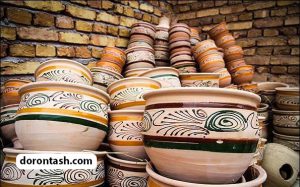
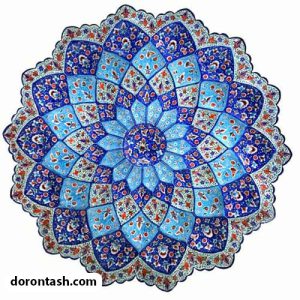 Pottery making in Iran has a long and brilliant history. Due to the special geographical location of Iran, which is located at the intersection of ancient civilizations and on the routes of important caravans, almost every part of Iran has been engaged in making pottery at different times. However, recent excavations and archeological research showed that there are four major areas in the production of pottery in the Iranian Plateau, which includes the Naskht section, which includes the west of the Zakars Mountains and Lorestan areas. The second part includes the areas south of the Caspian Sea, which includes the provinces of Gilan and Mazandaran. These two regions were the first regions in the Iranian plateau that started pottery. The third part includes the northwest of the country and the regions of Azerbaijan, the fourth part is in the southeast, which includes the provinces of Kerman and Sistan and Baluchistan. In addition to these 4 regions, the desert regions of Iran can also be added to it, where pottery production dates back to the 8th millennium BC.
Pottery making in Iran has a long and brilliant history. Due to the special geographical location of Iran, which is located at the intersection of ancient civilizations and on the routes of important caravans, almost every part of Iran has been engaged in making pottery at different times. However, recent excavations and archeological research showed that there are four major areas in the production of pottery in the Iranian Plateau, which includes the Naskht section, which includes the west of the Zakars Mountains and Lorestan areas. The second part includes the areas south of the Caspian Sea, which includes the provinces of Gilan and Mazandaran. These two regions were the first regions in the Iranian plateau that started pottery. The third part includes the northwest of the country and the regions of Azerbaijan, the fourth part is in the southeast, which includes the provinces of Kerman and Sistan and Baluchistan. In addition to these 4 regions, the desert regions of Iran can also be added to it, where pottery production dates back to the 8th millennium BC.
Music
Iranian traditional music, including instruments, songs, and songs, has flowed side by side in the text of the Iranian people since thousands of years before Christ, and what was more pleasant, simpler and understandable is available today, a large part of Asia. Middle East, Afghanistan, Pakistan, Republic of Azerbaijan, Armenia, Turkey, and Greece are influenced by this music and each of them have had their own influence in the formation of this music. Among the musicians or in other words musicians in ancient Iran, we can mention “Barbad” and ” Nakissa” pointed out.
the literature
Persian literature is literature written in Persian language. Persian literature has a history of one thousand and one hundred years. Persian poetry and Persian prose are two main genres in Persian literature. Some old books on non-literary subjects such as history, prayers and various sciences also have literary value and with the passage of time they have become among the classical works of Persian literature.
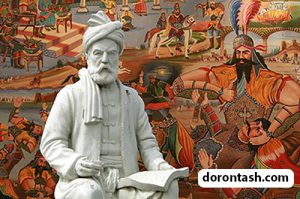 The fame of some Iranian poets and writers has gone beyond the borders of Iran. Poets and writers such as Ferdowsi, Saadi, Hafez Shirazi, Molavi, Omar Khayyam and Nizami are world famous. Among the well-known figures of contemporary Persian literature in the world, we can mention Sadegh Hedayat in fiction and Ahmad Shamlou in poetry.
The fame of some Iranian poets and writers has gone beyond the borders of Iran. Poets and writers such as Ferdowsi, Saadi, Hafez Shirazi, Molavi, Omar Khayyam and Nizami are world famous. Among the well-known figures of contemporary Persian literature in the world, we can mention Sadegh Hedayat in fiction and Ahmad Shamlou in poetry.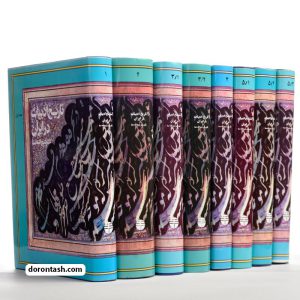
Environment design
Iran’s architecture has special values compared to the architecture of other countries in the world. Features such as appropriate design, accurate calculations, types of structures, correct form of covering, compliance with technical and scientific issues in the building, lofty porches, tall columns, and finally various decorations, each of which represents the splendor of Iranian architecture at the same time. The history of Iranian architecture reaches around the 7th millennium BC. Iranian architecture also has unique features in some fields, which led to the introduction of new achievements to the world of architecture, including special spaces such as porches, domes, Iranian courtyards, etc., advanced structures such as double and triple arches. Central, types of domes, types of corners and…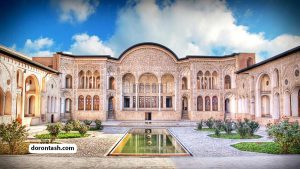
Special uses such as gardens
Special concepts with different definitions such as geometric decorations, introversion, extroversion, design patterns, etc.
Achaemenian architecture refers to the achievements of Achaemenid Iranians in the construction of spectacular and attractive cities (Takht Jamshid, Susa, Hegmetane), temples for worship and social gatherings (such as Zoroastrian temples) and tombs of past kings (such as the tomb of Cyrus the Great). One of the fundamental features of this architecture is its combination with Medes, Assyrian, Greek and Asian elements. The legacy of Achaemenid architecture began with the expansion of the empire around 550 BC. With the emergence of the second Iranian empire, the Sassanid Empire (224-624 AD), Achaemenid traditions were revived with the construction of special fire temples and huge palaces.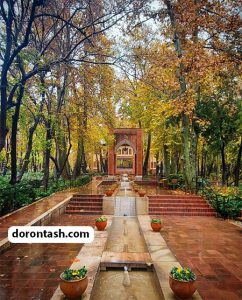
Iranian Garden
Iranian garden refers to its unique structure and design. Pasargad Iranian garden is considered the origin of these gardens’ architecture. Cyrus the Great had personally ordered how to create the garden of Pasargad and how to plant the trees, and in fact the geometry of the garden and its shape and icon from the point of view that Cyrus was taken as an Iranian garden. During the Sassanid period, gardens were formed in front of palaces and temples, and this issue continued in the Islamic period as well. As a complete structure, these gardens express the close relationship between the cultural and natural environment and are a sign of adapting and harmonizing the needs of man and nature.
In the past, the Iranian garden was the manifestation of the hidden power of the environment and the perception of its complexities. By relying on his experimental knowledge, the creator of the garden created a space that made the natural substrate survive and dynamism. In 2011, at the 35th meeting of UNESCO, 9 Iranian gardens were accepted as UNESCO World Heritage. These gardens include the Iranian gardens of Pasargad, Eram, Chehelston, Fin, Abbasabad, Shazdeh, Daulatabad, Pahlavanpur, and Akbariyeh.
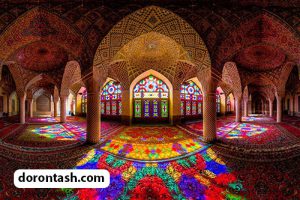 calligraphy
calligraphy
Nastaliq cursive fragment by Seyyed Ali Akbar Golestane, 1316 AH. Q, the text is a verse by Saadi Shirazi that says: O you who give me advice, go after the righteous / love is true if you allow carrying. In this calligraphic work, the word “if” has been removed.
Iranian calligraphy is a part of Islamic calligraphy that was gradually formed around the Iranian culture in Iran and its dependent lands or under its influence, such as the countries of Central Asia, Afghanistan and the Indian subcontinent. And it is considered not only one of the prides of Iranian art, but also one of the prides of Islamic art and even world art.
the cinema
The first video camera came to Iran during Mozafaruddin Shah’s time. The first Farsi sound film was Dokhtar Ler, which was made by Abdul Hossein Sepanta in 1317. The arrival of the first cinematograph in Iran in 1279 AH by Mozafaruddin Shah is considered the beginning of Iranian cinema, although the construction of the first public cinema hall did not happen until 1291. Until 1308, no Iranian films were made, and the few established cinemas showed western films, which sometimes had Persian subtitles. The first feature film of Iran named “Abi and Robi” was made in 1308 by Evans Oganians, with the cinematography of Khan Baba Motazadi.
Zaribafi
It is stated in Dr. Moin’s dictionary: Zari means fabric made of gold. A cloth whose wefts are made of gold. Zari or Zarbaft is a delicate and very expensive fabric whose warp or thread is made of pure silk and its wefts are colored silk and one of the wefts is Gulabtun thread, which can be Zari or Simin. Zari is the most exquisite and legendary Iranian textile, which had a worldwide reputation during its boom and popularity, and now examples of it are adorning museums and other art centers in Iran and other countries of the world, and it has a long history in terms of texture and production. According to historical traditions, the texture of the fabrics that use Glabton threads in their text and motifs reaches seven thousand years ago.
- Khatam Kari
- Khatamkari
- Enamels
- Enamels
- Relief and sculpture
- The prominent figures of Persepolis
- penmanship
- Giwa
- cashew
- Gallesh
- Etched
- Iranian jeweler
Architecture at different times, since the beginning of the Median Empire era, had great splendor and progressed. At the end of this historical stage, the architecture of the Islamic period, with equipment and taste in the Sassanid style, had such an effect that it is rare in the world. At the same time, Iranian Muslim artists built and created arches, decorative manuscripts, and various magnificent color designs in religious areas. The development of other arts, such as metal works, textiles, glass works, painting, pottery and other works of Iranian national art, took a long time. Sometimes, historical events, war, victory, invasion of foreigners, isolation and rule of kings, natural events, drought, famine and earthquake left their impact on the course and development of works of art.


